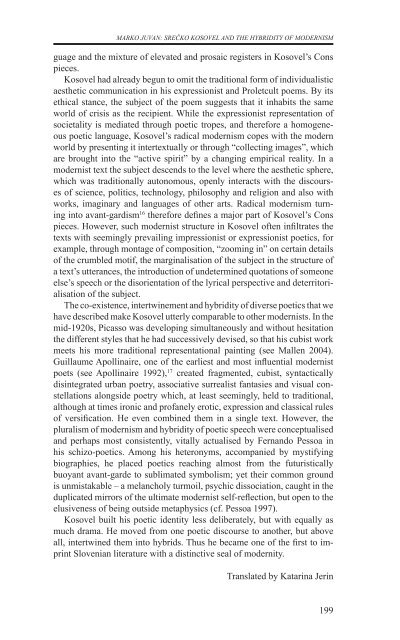razprave (pdf) - Društvo za primerjalno književnost - ZRC SAZU
razprave (pdf) - Društvo za primerjalno književnost - ZRC SAZU
razprave (pdf) - Društvo za primerjalno književnost - ZRC SAZU
- No tags were found...
You also want an ePaper? Increase the reach of your titles
YUMPU automatically turns print PDFs into web optimized ePapers that Google loves.
MARKO JUVAN: Srečko Kosovel and the Hybridity of Modernismguage and the mixture of elevated and prosaic registers in Kosovel’s Conspieces.Kosovel had already begun to omit the traditional form of individualisticaesthetic communication in his expressionist and Proletcult poems. By itsethical stance, the subject of the poem suggests that it inhabits the sameworld of crisis as the recipient. While the expressionist representation ofsocietality is mediated through poetic tropes, and therefore a homogeneouspoetic language, Kosovel’s radical modernism copes with the modernworld by presenting it intertextually or through “collecting images”, whichare brought into the “active spirit” by a changing empirical reality. In amodernist text the subject descends to the level where the aesthetic sphere,which was traditionally autonomous, openly interacts with the discoursesof science, politics, technology, philosophy and religion and also withworks, imaginary and languages of other arts. Radical modernism turninginto avant-gardism 16 therefore defines a major part of Kosovel’s Conspieces. However, such modernist structure in Kosovel often infiltrates thetexts with seemingly prevailing impressionist or expressionist poetics, forexample, through montage of composition, “zooming in” on certain detailsof the crumbled motif, the marginalisation of the subject in the structure ofa text’s utterances, the introduction of undetermined quotations of someoneelse’s speech or the disorientation of the lyrical perspective and deterritorialisationof the subject.The co-existence, intertwinement and hybridity of diverse poetics that wehave described make Kosovel utterly comparable to other modernists. In themid-1920s, Picasso was developing simultaneously and without hesitationthe different styles that he had successively devised, so that his cubist workmeets his more traditional representational painting (see Mallen 2004).Guillaume Apollinaire, one of the earliest and most influential modernistpoets (see Apollinaire 1992), 17 created fragmented, cubist, syntacticallydisintegrated urban poetry, associative surrealist fantasies and visual constellationsalongside poetry which, at least seemingly, held to traditional,although at times ironic and profanely erotic, expression and classical rulesof versification. He even combined them in a single text. However, thepluralism of modernism and hybridity of poetic speech were conceptualisedand perhaps most consistently, vitally actualised by Fernando Pessoa inhis schizo-poetics. Among his heteronyms, accompanied by mystifyingbiographies, he placed poetics reaching almost from the futuristicallybuoyant avant-garde to sublimated symbolism; yet their common groundis unmistakable – a melancholy turmoil, psychic dissociation, caught in theduplicated mirrors of the ultimate modernist self-reflection, but open to theelusiveness of being outside metaphysics (cf. Pessoa 1997).Kosovel built his poetic identity less deliberately, but with equally asmuch drama. He moved from one poetic discourse to another, but aboveall, intertwined them into hybrids. Thus he became one of the first to imprintSlovenian literature with a distinctive seal of modernity.Translated by Katarina Jerin199
















